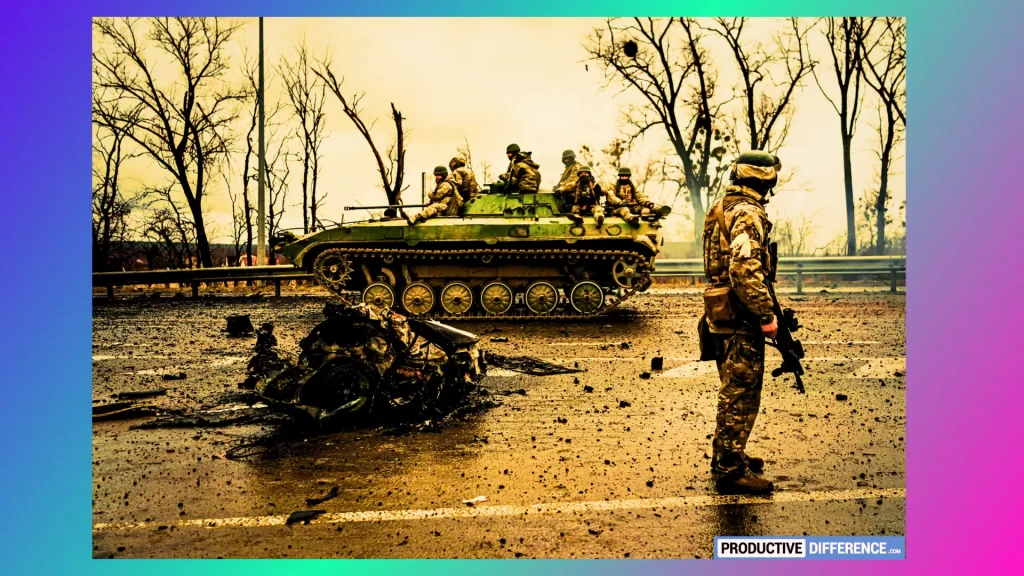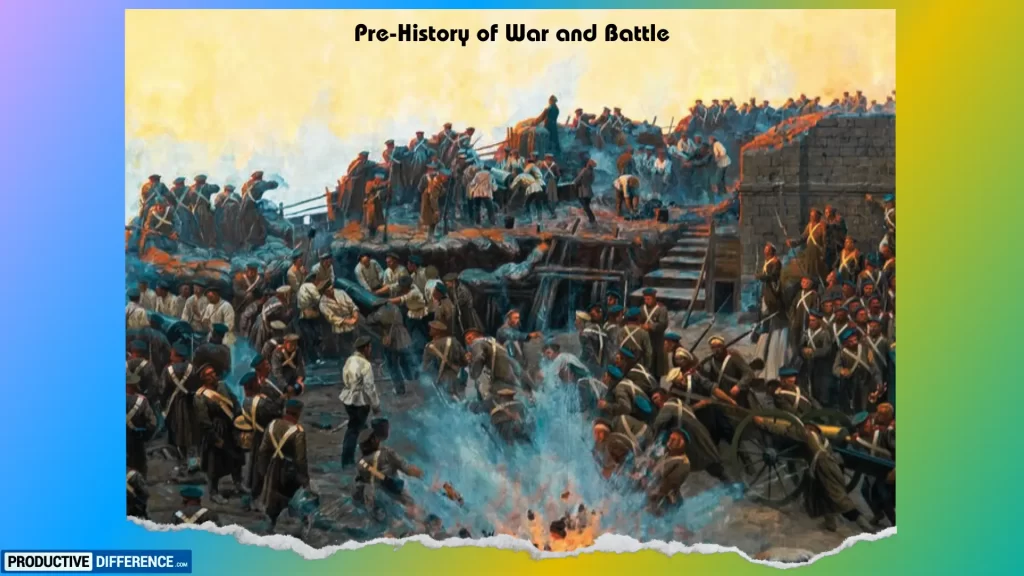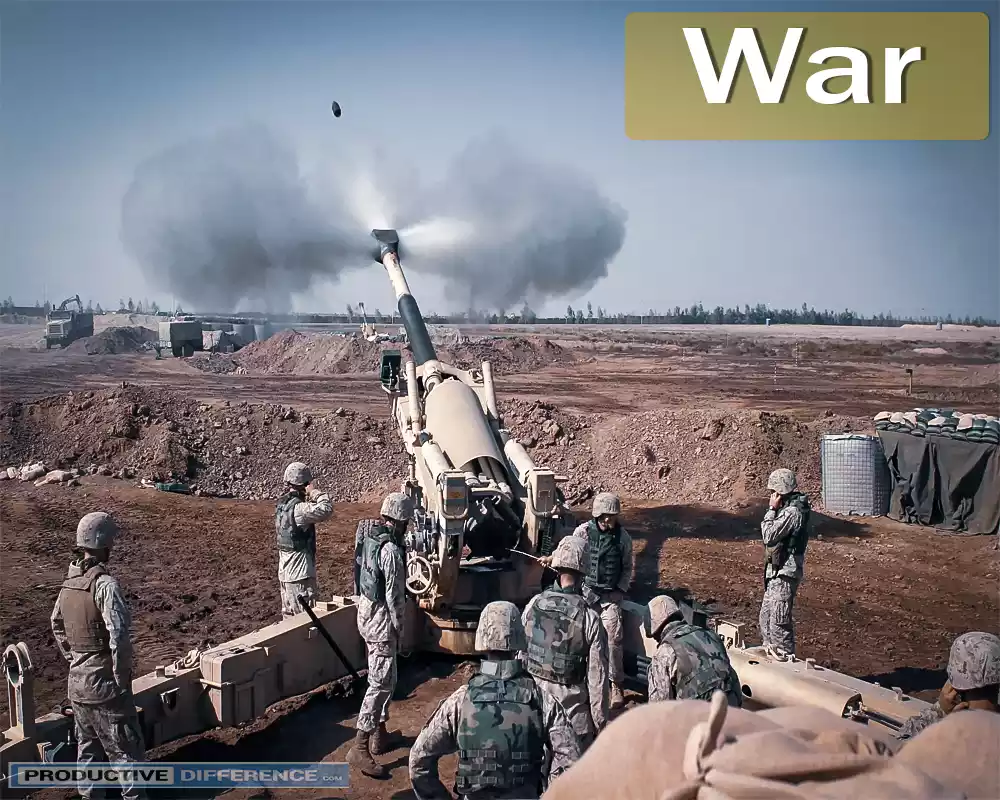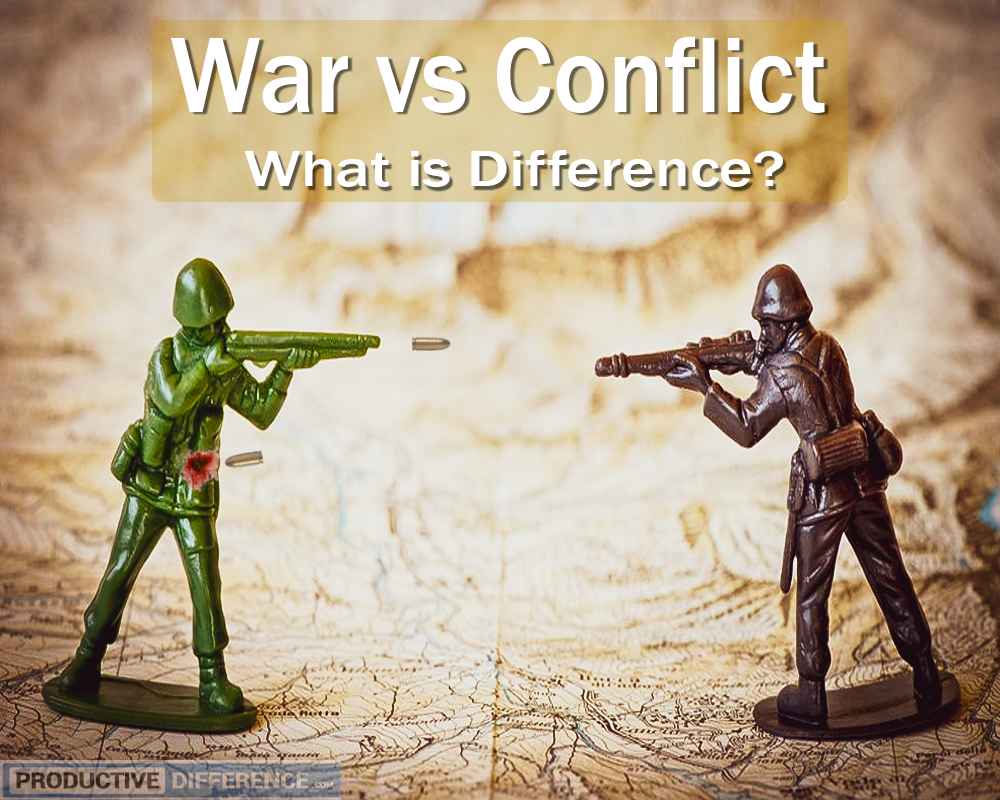Introduction of War and Battle

The difference between war and battle lies in their scope, duration, and impact. War is a comprehensive conflict involving multiple nations or states, driven by political motivations and lasting for extended periods. Battles, on the other hand, are specific engagements between opposing military forces, with defined objectives and shorter durations. While wars have far-reaching consequences on societies and geopolitical landscapes, battles are tactical confrontations that contribute to the overall outcome of a war. Understanding this distinction is crucial to comprehending the complexities of armed conflicts throughout history.
The Pre-History of War and Battle
The pre-history of war and battle takes us back to the earliest periods of human civilization, where conflicts and confrontations were a part of daily life. While written records from these times are scarce, archaeological evidence provides insights into the prehistoric origins of war and battle.
During the Paleolithic era, which spans from around 2.6 million years ago to 10,000 BCE, human societies were largely hunter-gatherer communities. Competition for resources, territory, and mates likely led to conflicts among these early groups. Archaeological sites have revealed skeletal remains with evidence of violence, such as weapon-inflicted injuries and mass burials, suggesting the occurrence of interpersonal or intergroup conflicts.
As humans transitioned to a more sedentary lifestyle during the Neolithic period (10,000 BCE to 4,500 BCE), the establishment of permanent settlements and the development of agriculture brought new complexities to conflicts. With the concept of land ownership and the accumulation of surplus resources, disputes over territories and resources became more common. The need to defend these settlements against external threats likely gave rise to organized defense mechanisms and the emergence of early forms of warfare.
The Bronze Age (approximately 3,300 BCE to 1,200 BCE) witnessed significant advancements in weaponry and military technology. The introduction of bronze, an alloy of copper and tin, allowed for the production of stronger and more effective weapons. This era marked the transition from simple handheld weapons like stone-tipped spears to more sophisticated weapons such as swords, axes, and bows and arrows. The rise of fortified settlements and the construction of defensive structures demonstrate the increasing importance of protection and the anticipation of conflicts.

Written records from ancient civilizations such as Mesopotamia and Egypt and Indus Valley provide a glimpse into early battles and warfare. The accounts of wars, conquests, and campaigns can provide insight into ancient army tactics and strategies.
Throughout prehistory, battles were often fought for various reasons, including territorial expansion, resource acquisition, defense, and the establishment of dominance. The development of organized warfare and the emergence of military leaders played significant roles in shaping the outcomes of these battles. As societies became more complex, battles were no longer random skirmishes but rather planned and orchestrated engagements with clear objectives.
The pre-history of war and battle sets the stage for the subsequent development of warfare throughout human history. It highlights the intrinsic nature of conflict and the continual evolution of military tactics, technologies, and strategies. Understanding the prehistoric origins of war and battle provides a foundation for exploring the complexities of armed conflicts that have shaped our world.
Memorable History of War and Battle
Throughout recorded history, war and battle have left an indelible mark on civilizations and shaped the course of human events. From ancient empires to modern conflicts, the pages of history are filled with stories of memorable wars and battles that continue to captivate our imagination.
Homer’s Iliad makes known the Trojan War, one of the best-known conflicts ever waged between Greeks and Trojans around the 12th century BCE, depicted as depicted through legendary heroes Achilles and Hector. Provoked by Helen’s abduction by Achilles of Sparta (Queen of Sparta), which resulted in her subsequent abduction, this long conflict ultimately culminated with Hector launching the famed “Trojan Horse stratagem”, leading to their defeat and leading them all together in the defeat of Troy itself ten years before finally leading them all in defeat!
In ancient times, the Battle of Thermopylae holds a special place in history. Fought in 480 BCE between an alliance of Greek city-states, led by King Leonidas of Sparta, and the Persian Empire under King Xerxes, the battle showcased the bravery and military prowess of the Greeks. Despite being vastly outnumbered, the Greeks held the narrow pass of Thermopylae for several days, delaying the Persian advance and allowing the Greeks to regroup. Although ultimately defeated, their sacrifice became an enduring symbol of courage and resistance.
The Battle of Marathon in 490 BCE is another notable event in ancient Greek history. It saw the Athenians repel a Persian invasion force, securing a crucial victory for Greece. Legend has it that a messenger named Pheidippides ran from the battlefield to Athens, delivering the news of the victory before collapsing from exhaustion, inspiring the creation of the modern-day marathon race.
From here forward in history, Hastings changed both England and Europe drastically. It marked William the Conqueror’s decisive Norman conquest of England; during which battle between Normans led by King Harold II of Anglo-Saxon forces led by Harold III was waged resulting in Harold’s death as well as Norman rule over England which ultimately had far-reaching implications on English culture, language, and governance.
The Napoleonic Wars of late 18th and early 19th-century Europe are widely viewed as being pivotal events. Led by Napoleon Bonaparte – an esteemed military leader known for spearheading numerous campaigns that altered Europe’s political map – Napoleon Bonaparte launched numerous battles, most significantly Waterloo in 1815 where an allied force under the Duke of Wellington marked his downfall and resulted in monarchy being restored across France.
In the 20th Century, two global wars left an indelible mark on human history: World Wars I (14-18) and II (1939-1945) were global conflicts fought to devastating ends with tragic outcomes for soldiers and civilians alike; Verdun, Somme, Stalingrad Normandy Midway remain vivid in our collective memories as testaments to sacrifice and courage among millions of soldiers and civilians involved.
Recent history, from the Gulf War of 1990-1991 and more recently Iraq and Afghanistan conflicts has transformed the geopolitical landscape of the Middle East and beyond. These wars introduced novel dimensions of warfare such as asymmetrical tactics to technological developments.
The memorable history of war and battle showcases the triumphs, tragedies, and complexities of human conflict. These events have left lasting impressions on nations, cultures, and individuals, and continue to be studied and commemorated as reminders of the human experience in times of war.
Let’s know about War and Battle
War and battle are two interconnected terms within the context of armed conflict.
War
War refers to a prolonged and comprehensive conflict between nations, states, or other organized groups. It involves large-scale confrontations and encompasses a series of battles and engagements. Wars are often driven by political motivations, such as disputes over territory, resources, or ideological differences. They can span over extended periods and have far-reaching consequences on societies and geopolitical landscapes. Decision-making by political leaders plays a crucial role in initiating and sustaining wars.

Battle
Conversely, battle refers to any engagement between opposing military forces. It involves tactical confrontation with a specific objective in mind and usually lasts less time compared to wars. Battles may take place on land, sea, or air depending on the nature and severity of the conflict. Commanders devise strategies and objectives designed to secure victory during particular clashes; their goals could include seizing strategic locations or defeating opposing forces as well as safeguarding key assets – battles are an integral component of wars, contributing to overall outcomes and advancement.

While wars encompass multiple battles and have broader political implications, battles are localized instances of armed clashes that take place within the larger context of a war. Understanding the difference between war and battle is essential for comprehending the complexities of armed conflicts throughout history and appreciating the significance of individual engagements within the broader picture.
Characteristics of War and Battle
Characteristics of War:
- Prolonged Conflict: Wars are prolonged and enduring conflicts that can last for months, years, or even decades. They involve sustained military operations and engagements.
- Organized Parties: Wars involve organized groups, such as nations, states, or alliances, with defined leadership structures and military forces.
- Large-Scale Operations: Wars encompass large-scale military operations that can involve multiple fronts, theaters of war, and the mobilization of significant resources.
- Political Motivations: Wars often have underlying political motivations, such as territorial disputes, ideological differences, or the pursuit of power and influence.
- Comprehensive Impact: Wars have a comprehensive impact on societies, economies, and geopolitical landscapes. They can disrupt daily life, cause significant destruction, and have long-term consequences.
- Widespread Violence: Wars involve widespread violence, including direct combat, bombings, and other forms of military aggression. Civilians are often affected, and collateral damage is a common occurrence.
Characteristics of Battle:
- Defined Objective: Battles have a specific objective or goal, such as capturing a strategic location, defending a position, or defeating enemy forces in a particular engagement.
- Tactical Engagement: Battles are tactical, focusing on the immediate situation at hand. They involve the use of military strategies, formations, and maneuvers to gain an advantage over the enemy.
- Limited Duration: Battles are relatively shorter in duration compared to wars. They are intense, concentrated engagements that can last from a few hours to several days, depending on the scale and circumstances.
- Direct Confrontation: Battles involve a confrontation between military units or forces from opposing sides and can take place either on land, at sea, or even on air depending on their nature and where their conflict originates.
- Military Factors: Battles heavily rely on military factors such as troop movements, firepower, logistics, and the application of tactical skills to achieve victory.
- Contribution to War: Battles are integral components of wars, collectively shaping the progress and outcome of a conflict. They contribute to the overall strategic picture and can be decisive in determining the course of a war.
Both war and battle share the common element of armed conflict but differ in terms of scale, duration, objectives, and impact. Wars encompass multiple battles and have broader implications, while battles are specific engagements within the context of a war. Understanding the characteristics of war and battle is crucial for analyzing and interpreting the dynamics of armed conflicts throughout history.
The main difference between War and Battle
The main difference between war and battle lies in their scope, duration, and impact.
War:
- War is a comprehensive conflict involving multiple nations, states, or organized groups.
- It is characterized by prolonged duration, often lasting for months, years, or even decades.
- Wars have far-reaching consequences on societies and geopolitical landscapes.
- Political motivations such as territorial conflicts, ideologies, or power-seeking are often behind them.
- Wars encompass a series of battles and military operations that collectively contribute to the overall outcome of the conflict.
Battle:
- A battle is a specific engagement between opposing military forces.
- It has a defined objective or goal, such as capturing a strategic location or defeating enemy forces in a particular engagement.
- Battles are relatively shorter in duration compared to wars, ranging from a few hours to several days.
- They are tactical, focusing on the immediate situation and employing military strategies and maneuvers.
- Battles are integral components of wars, contributing to the overall progress and outcome of the conflict.
War is a comprehensive and prolonged conflict between nations or organized groups, while a battle is a specific engagement within the larger context of a war. Wars have broader political and societal implications, while battles are localized instances of armed combat with defined objectives. Understanding this distinction is essential for comprehending the complexities of armed conflicts throughout history.
Comparison Table between War and Battle
| Aspect | War | Battle |
|---|---|---|
| Scope | Involves multiple nations or organized groups | Specific engagement within a war |
| Duration | Prolonged, lasting for months, years, or decades | Relatively shorter, ranging from hours to days |
| Impact | Far-reaching consequences on societies and geopolitical landscapes | The immediate impact on the outcome of a specific engagement |
| Motivation | Driven by political factors, territorial disputes, or ideological differences | Tactical objectives, such as capturing a location or defeating enemy forces |
| Nature | Comprehensive conflict involving multiple operations and engagements | The focused and tactical confrontation between military forces |
Relationship between War and Battle
The relationship between war and battle is interconnected and symbiotic. While war and battle are distinct concepts, they are closely linked and mutually influence each other in the context of armed conflict.
War, as a comprehensive conflict, encompasses multiple battles. It is the overarching state of conflict between nations, states, or organized groups. Wars are driven by political, social, or ideological motivations and involve prolonged engagements with far-reaching consequences. Wars provide the strategic and political framework within which battles are fought.
Battles, on the other hand, are specific engagements within the larger context of a war. They are tactical confrontations between opposing military forces with defined objectives. Battles contribute to the overall progress and outcome of a war, as they directly impact the balance of power and determine the success or failure of specific military operations.
Battles form the core of war. They help shape its course by impacting factors like territorial control, military strategies, and the morale of opposing forces – each battle can have an immense effect on its course and the eventual result. Winning or decisive battles can drastically shift war dynamics affecting both its trajectory and ultimate result.
Conversely, wars provide the context and motivation for battles. Wars set the stage for conflicts, establish objectives and motivations, and determine the overall strategic direction. Battles occur within this broader framework, with commanders and soldiers executing tactics and strategies to achieve specific goals that contribute to the larger war effort.
Understanding the relationship between war and battle is crucial for comprehending the dynamics and complexities of armed conflicts throughout history. Wars cannot be fully understood without analyzing the battles that shape them, and battles gain significance and context within the broader framework of war.
Political Motivations of War and Battle
War and battle can be motivated by a range of political factors that drive nations, states, or organized groups to engage in armed conflict. The political motivations behind war and battle can vary significantly depending on the historical context and specific circumstances.
Here are some common political motivations:
- Territory and Borders: Disputes over territorial claims or border conflicts can lead to armed conflict. Nations or groups may engage in war or battle to secure or expand their territories, protect their borders, or assert their sovereignty.
- Ideological Differences: Conflicts rooted in ideological differences, such as political systems, religious beliefs, or cultural values, can fuel armed conflict. These differences may lead to wars or battles fought to defend or promote specific ideologies or worldviews.
- Power and Influence: War and battle often arise from aspirations for power and influence. Political entities may engage in armed conflict to gain control over strategic resources, establish dominance in a region, or enhance their geopolitical position.
- Nationalism and Patriotism: Strong feelings of nationalism or patriotism can drive societies to engage in war or battle. The defense of national identity, and cultural heritage, or the protection of citizens’ interests can motivate armed conflict.
- Economic Interests: Wars and battles can be influenced by economic factors. Control over valuable resources, trade routes, or access to markets can lead to conflicts as nations or groups vie for economic advantages or attempt to safeguard their economic interests.
- Alliances and Power Balances: Political alliances and power dynamics between nations can contribute to the outbreak of wars or battles. Entering into or breaking alliances, maintaining military balances, or countering perceived threats can motivate armed conflict.
These political motivations are not exhaustive, and war and battle can have multiple intertwined motives. Additionally, individual conflicts may have unique factors that drive their political motivations, making each situation distinct. Understanding the political motivations behind war and battle provides insight into the complex dynamics that lead to armed conflict and shape the course of history.
Examples and Historical Context of War and Battle
Examples and Historical Context of War:
- World War II (1939-1945): World War I involved multiple nations from around the globe – such as the major Allies such as the United States, UK, and Soviet Union) as well as Axis powers like Germany Italy Japan; large-scale military operations occurred with major battles taking place that left significant social, political, economic repercussions behind them.
- American Civil War (1861-1865): Civil War in the United States. The conflict began as tension over slavery and state rights escalated; ultimately leading to profound social and political transformation throughout the nation.
- Napoleonic Wars (1803-1815): Conflicts were fought between Napoleon Bonaparte’s French Empire and various European powers during which Austerlitz, Waterloo, and Trafalgar saw major battles as Europe was transformed politically. These wars dramatically rewrote its political landscape with significant battles such as Austerlitz Waterloo & Trafalgar taking place over three distinct periods.
Examples and Historical Context of Battle:
- Battle of Gettysburg (1863): Fought during the American Civil War, it was a turning point in the conflict. The battle took place in Gettysburg, Pennsylvania, and resulted in a decisive Union victory, halting the Confederate advance into the North.
- Battle of Stalingrad (1942-1943): World War II’s crucial battle between German and Soviet forces over Stalingrad marked an inflection point that ultimately lead to their defeat; marking one of several milestones during Eastern Front operations against Axis powers in Eastern Europe.
- Battle of Thermopylae (480 BCE): Fought between the Persian Empire and an alliance of Greek city-states, led by King Leonidas of Sparta. The battle showcased the bravery and resistance of the Greeks against overwhelming odds and has become legendary in history and popular culture.
These examples demonstrate the historical context and significance of both war and battle. Wars encompass multiple battles and have far-reaching consequences, while battles are specific engagements that shape the outcomes of wars and have their historical importance.
Conclusion
War and battle are interconnected elements of armed conflict, each with its distinct characteristics and contributions. War represents a comprehensive and prolonged conflict that involves multiple nations or organized groups. It is driven by political, territorial, or ideological motivations, and its impact extends beyond the battlefield, shaping societies, economies, and geopolitical landscapes. Wars have the potential to alter the course of history and leave lasting legacies.
Battle refers to specific engagements within the larger context of a war. Battles are tactical confrontations that occur within a defined timeframe and location. They are characterized by strategic planning, military maneuvers, and the pursuit of immediate objectives. The outcome of battles directly influences the progression and outcome of a war.

